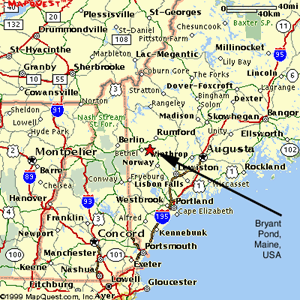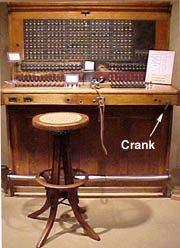
phone
cards
all you need to know about
 |
|
phone | |
all you need to know about | |||
Telephone History Series
by Tom FarleyPage 11 >> 1983 to 1984  Michael Hathaway reports that "[My] parents owned the Bryant Pond Telephone Company in Bryant Pond, Maine, the last hand-crank magneto company to go dial. It was in our living room and the last call was made October 11, 1983." Hand crank magneto switchboards evolved around the turn of the century. Their arrangement was not common battery, where the exchange or central office powers their equipment and supplies electricity to customer's phones. Rather, as we saw earlier in this series, a crank at the switchboard operators position was turned to signal a customer. Turn the crank and you caused a dial at a customer's telephone to ring, a magneto in the crank generating the ringing current. To place a call a customer signaled the operator with a similiar crank on their telephone. A big battery in the base of the customer's telephone supplied the talking power when a call got connected. This system is called local battery, where the customer's phone supplies the power. Here's an example of a magneto switchboard below, a 1914 Western Electric Type 1200, known as a "Bull's Eye." This board is at the Roseville Telephone Company Museum and it still works for demonstrations.  "My father and mother Elden & Barbara Hathaway sold the Bryant Pond Telephone Company in 1981 but it took two years to convert. They did have about 400 customers ( probably 200 lines - two switchboards full). When they bought the company there were only 100 customers. The Oxford County Telephone Company, which bought it, retained ownership of the last operating switchboards, and they are currently deciding what they would like to do with them. The options include giving them to the town of Bryant Pond, and I have heard there is interest from the Smithsonian. My mother, who is 83, thinks that's quite exciting. A lot of the family memorabilia has been donated to the Fryeburg Fair (Maine) Farm Museum, which although is only open during the 8 day fair, is visited by many thousands each year. It is hoped to have within a year or so a working magneto switchboard there where someone can call from an old pay phone to anywhere. My mother has a lot of telephone parts left over which we are slowly marketing for her as memorabilia from the last old hand-crank magneto company. I've actually written a book about the Bryant Pond Telephone Company called 'Everything Happened Around The Switchboard.' It's (obviously) a story of family life around the switchboard and is light reading with hopefully humor and nostalgia." To sum up, although some manual switchboards may have remained in the PSTN, those being small office switches, or PBXs, the Bryant Pond board remains the last central office manual exchange in America. On this happy and nostalgic note of technology passing away, so at the same time was the world's greatest telephone company coming to an end. Although they had pioneered much of telecom, many people though the information age was growing faster than the Bell System could keep up. Many thought AT&T now stood in the way of development, rather than being the harbinger of it. And the thought of any large monopoly struck most as inherently wrong. In 1982 the Bell System had grown to an unbelievable 155 billion dollars in assets (256 billion in today's dollars), with over one million employees. By comparison, Microsoft in 1998 had assets of around 10 billion dollars. On August 24, 1982, after seven years of wrangling, the Bell System was split apart, succumbing to government pressure from without and a carefully thought up plan from within. Essentially, the Bell System divested itself. Judge Harold Greene entered a decision called the Modified Final Judgment, since it impacted the 1956 decision limiting AT&T to the telephone business. In the MFJ as it is known, AT&T kept their long distance service, Western Electric, Bell Labs, the newly formed AT&T Technologies and AT&T Consumer Products. AT&T got their most profitable companies, in other words, and spun off the regional Bell Operating Companies or RBOCs. Complete divestiture took place on January, 1, 1984. In perhaps the most cumbersome part of the Modified Final Judgment, Judge Greene split the country into 160 local access and transport areas, loosely structured around area code boundaries. Local phone companies would not provide long distance service and long distance companies could not provide local service. Judge Greene thought the Baby Bells would dominate long distance service in their territories if allowed to provide it. He insisted that only a long distance company could pass LD traffic from one LATA to another. By now this prohibition has ceased on a federal level, however, many states have yet to allow complete local and long distance competition. And although AT&T once again provides local service for a few select markets, as of July, 2001, only 8% of local lines belong to competitors, giving the local telephone companies a practical monopoly Theodore Vail would have preferred. Epilogue I: the death of Western Electric "On January 1, 1984, the Western Electric Company, then older than the telephone itself, ceased to exist (Hochheiser 1991, 143). On that day of court ordered divestiture, the Bell System was broken into seven regional operating companies (the Baby Bells) and a more compact AT&T. AT&T retained the long-distance part of the business, its venerable research organization (Bell Laboratories), and its manufacturing operations (which could no longer have exclusive supply arrangements with the operating companies). A newly created AT&T Technologies, Inc. assumed the corporate charter of Western Electric and continued making 500-type,2500-type, and Trimline telephones under the AT&T Technologies label for several years at plants in Indianapois and Shreveport. However, to become competitive in the market, AT&T shifted residential telephone manufacturing to the Far East, beginning in Hong Kong in late 1985, Singapore the following year, and later in Bangkok and elsewhere. Thus ended U.S. production of rugged electromechanical telephones, and though phones similar to the 500-type, the 2500-type, the Princess, and the Trimline are still made to-day, they are products of the modern electronics age, rather than a bygone culture." Epilogue II: A personal note on W.E.C.O. Yesterday I brought home a battered and rotten wooden crate I found outside a second hand store. I say outside because it was in such bad shape that not even the thrift store thought it saleable, they discarded it instead. Hardly fit as even a garden planter, I brought this oily and broken box home because of two words stenciled in three inch letters on the lengthwise sides: Western Electric. Gone are the rope handles and original hinges, and although the clasp appears genuine, it has been torn off once or twice and mounted in a new location each time. The stylized Bell System logo accompanies the lettering. There is an address on it. In handwriting that could only be penned by someone now in their 70s, the labeling reads, WECO, 1610 N. Broadway, Stockton, California. B/C 45738. I'm not sure if I will restore the box, put plants in it, or put the boards with the wording into a frame. It seems so sad and I keep thinking of the Ralph Myers' quote I used above... Epilogue III: Graham versus Gray I haven't given my opinion directly as to who was first at the patent office, Gray or Bell. I'm not sure I can do it now, at least, not without being long winded. But let me try, in long sentences. Detractors claim that the 600 court cases which followed the most valuable patent ever issued settled nothing. They say there was never any evidence that Bell did not cheat Gray. They try to prove a negative. They can't find any evidence that he cheated but they find nothing that absolutely clears Bell. He must have cheated. But in his entire life of being a man and a humanist, for all his later works of invention, and contributions to charity, the founding of the National Geographic Society, his continued work with the deaf, in his voluminous note taking of all things scientific, in all of this, in this incredible record, there is absolutely nothing in Bell's character that suggests he was a cheat. Nothing. Nothing! It is tough in this age of cynicism to admit that both Bell and Watson were truly great, gentle, brilliant men. Who deserved every bit of fame and accolade that came to them. Bell surrounded himself with sharp Boston lawyers to protect himself. But the animosity people had against his legal staff should in no way detract against Bell himself. Bell was an honest, courageous soul who long suffered being called a cheat. It was completely undeserved.
|